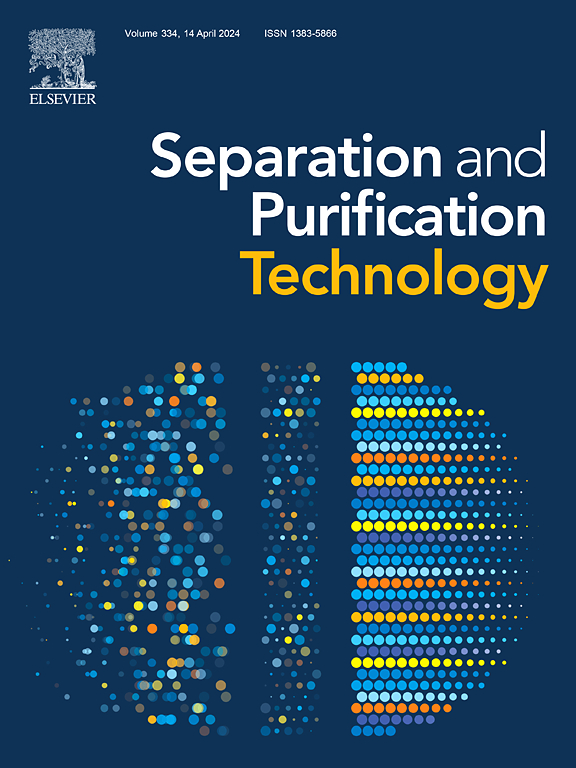后处理酰基氯交联增强木质素修饰纳滤膜的性能
IF 9
1区 工程技术
Q1 ENGINEERING, CHEMICAL
引用次数: 0
摘要
目前,制药废水的排放和抗生素的过度使用导致抗生素残留在水体中积累,对环境和人体健康构成严重威胁。纳滤膜由于其选择性渗透性,在抗生素的去除中得到了广泛的应用。然而,用可再生单体取代化石资源产生的单体在界面聚合中具有重要意义。为了解决这一挑战,木质素作为生物质源改性剂被纳入界面聚合过程。采用木质素基滤膜与二酰基氯化物交联的方法提高了滤膜的过滤性能。为了提高膜的性能,优化了酰基氯的选择,研究了线性二酰基氯分子链长度的变化对膜交联特性的影响。通过渗透性测试,以及红外光谱、x射线光电子能谱和扫描电子显微镜等表征,全面评估了膜的性能。这些分析揭示了反应条件对膜性能的影响和潜在的反应机制。结果表明,与戊二酰氯交联的膜对Na2SO4的排异率显著提高,从90.2 %提高到96.7 %,对多种抗生素的排异率均达到95 %。该研究不仅扩大了生物质材料在纳滤膜制备中的应用,而且为高性能膜的开发提供了新的策略。本文章由计算机程序翻译,如有差异,请以英文原文为准。


Enhancement of lignin-modified nanofiltration membranes performance via acyl chloride crosslinking post-treatment
Nowadays, the discharge of pharmaceutical wastewater and the overuse of antibiotics have resulted in the accumulation of antibiotic residues in water body, posing a severe threat to environment and human health. Nanofiltration (NF) membranes, due to their selective permeability, have been widely applied in the removal of antibiotics. However, it is significant to replace the monomers produced by fossil resources in interfacial polymerization with renewable monomers. To address this challenge, lignin was incorporated as a biomass-source modifier into the interfacial polymerization process. Lignin-based NF membranes were crosslinked with diacyl chlorides to enhance their rejection performance. To enhance membrane performance, the acyl chloride selection was optimized, and the influence of molecular chain length variation in linear diacyl chlorides on membrane crosslinking characteristics was investigated. Membrane properties were thoroughly evaluated through permeability tests, along with characterizations including infrared spectroscopy, X-ray photoelectron spectroscopy, and scanning electron microscopy. These analyses shed light on the impact of reaction conditions on membrane performance and the underlying reaction mechanisms. The results demonstrated that the membrane crosslinked with glutaroyl chloride achieved a significant increase in Na2SO4 rejection, from 90.2 % to 96.7 %, and exhibited excellent rejection (>95 %) for various antibiotics. This study not only expands the use of biomass materials in the fabrication of NF membranes but also provides a new strategy for the development of high-performance membranes.
求助全文
通过发布文献求助,成功后即可免费获取论文全文。
去求助
来源期刊

Separation and Purification Technology
工程技术-工程:化工
CiteScore
14.00
自引率
12.80%
发文量
2347
审稿时长
43 days
期刊介绍:
Separation and Purification Technology is a premier journal committed to sharing innovative methods for separation and purification in chemical and environmental engineering, encompassing both homogeneous solutions and heterogeneous mixtures. Our scope includes the separation and/or purification of liquids, vapors, and gases, as well as carbon capture and separation techniques. However, it's important to note that methods solely intended for analytical purposes are not within the scope of the journal. Additionally, disciplines such as soil science, polymer science, and metallurgy fall outside the purview of Separation and Purification Technology. Join us in advancing the field of separation and purification methods for sustainable solutions in chemical and environmental engineering.
 求助内容:
求助内容: 应助结果提醒方式:
应助结果提醒方式:


